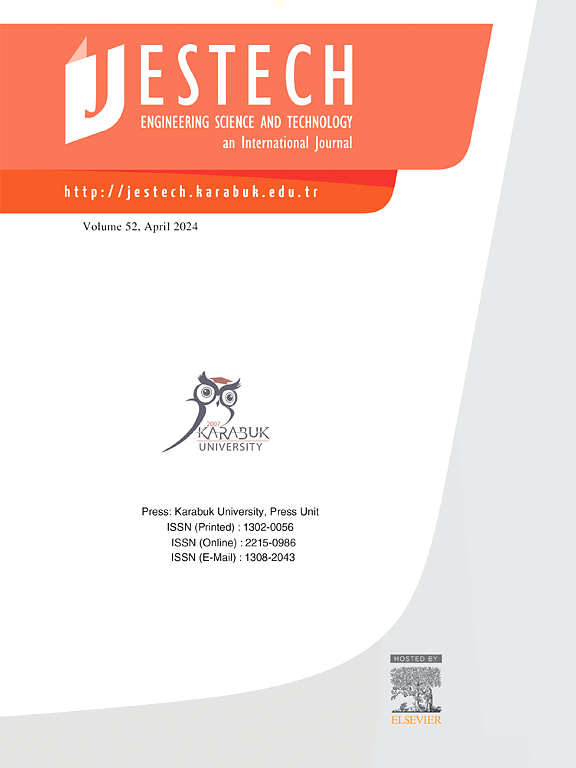A novel lightweight model for tea disease classification based on feature reuse and channel focus attention mechanism
IF 5.1
2区 工程技术
Q1 ENGINEERING, MULTIDISCIPLINARY
Engineering Science and Technology-An International Journal-Jestech
Pub Date : 2025-01-01
DOI:10.1016/j.jestch.2024.101940
引用次数: 0
Abstract
When collecting disease images in tea gardens, the collected images often include complex backgrounds. The complex backgrounds affect the recognition accuracy of traditional deep learning techniques. To improve the recognition accuracy, the traditional classic convolutional neural network (CNN) models require higher model complexity. This leads to a significant increase in computational cost and affects the running speed on edge computing devices. On the other hand, the popular vision transformer(ViT) model has a higher recognition accuracy as it has better global feature expression ability than CNN model. Since ViT models has a higher model complexity than CNN models, leading running slow on edge computing devices. In view of this, we propose a lightweight model named Lightweight Tea Diseases Detection Network (LTDDN). The LTDDN has higher recognition accuracy under the interference of complex backgrounds. Specifically, first, we propose the lightweight channel focus attention mechanism (CFA). The CFA focus the key features of the disease, improving the recognition accuracy. Second, we propose the feature reuse module (FRM). The FRM significantly reduces the parameters and computational costs of the model, making the model more lightweight. Finally, we propose a feature enhancement mobile inverted bottleneck convolution module(FEMBCM). The FEMBCM solves the problem of detail feature loss caused by traditional convolution downsampling. It improves recognition performance without increasing the complexity of the model. The analyses show that the parameter of LTDDN is only 1/30 of ResNet50 and 1/50 of ViTB16, which is more suitable for running in edge computing devices. Experimental results across self-built tea disease datasets, Mini-ImageNet, and PlantVillage datasets show LTDDN outperforms classic CNN, lightweight CNN, and popular ViT models in recognition accuracy. Based on the proposed model, an Android app has been developed to realize real-time, offline recognition of tea diseases in the field.
求助全文
约1分钟内获得全文
求助全文
来源期刊

Engineering Science and Technology-An International Journal-Jestech
Materials Science-Electronic, Optical and Magnetic Materials
CiteScore
11.20
自引率
3.50%
发文量
153
审稿时长
22 days
期刊介绍:
Engineering Science and Technology, an International Journal (JESTECH) (formerly Technology), a peer-reviewed quarterly engineering journal, publishes both theoretical and experimental high quality papers of permanent interest, not previously published in journals, in the field of engineering and applied science which aims to promote the theory and practice of technology and engineering. In addition to peer-reviewed original research papers, the Editorial Board welcomes original research reports, state-of-the-art reviews and communications in the broadly defined field of engineering science and technology.
The scope of JESTECH includes a wide spectrum of subjects including:
-Electrical/Electronics and Computer Engineering (Biomedical Engineering and Instrumentation; Coding, Cryptography, and Information Protection; Communications, Networks, Mobile Computing and Distributed Systems; Compilers and Operating Systems; Computer Architecture, Parallel Processing, and Dependability; Computer Vision and Robotics; Control Theory; Electromagnetic Waves, Microwave Techniques and Antennas; Embedded Systems; Integrated Circuits, VLSI Design, Testing, and CAD; Microelectromechanical Systems; Microelectronics, and Electronic Devices and Circuits; Power, Energy and Energy Conversion Systems; Signal, Image, and Speech Processing)
-Mechanical and Civil Engineering (Automotive Technologies; Biomechanics; Construction Materials; Design and Manufacturing; Dynamics and Control; Energy Generation, Utilization, Conversion, and Storage; Fluid Mechanics and Hydraulics; Heat and Mass Transfer; Micro-Nano Sciences; Renewable and Sustainable Energy Technologies; Robotics and Mechatronics; Solid Mechanics and Structure; Thermal Sciences)
-Metallurgical and Materials Engineering (Advanced Materials Science; Biomaterials; Ceramic and Inorgnanic Materials; Electronic-Magnetic Materials; Energy and Environment; Materials Characterizastion; Metallurgy; Polymers and Nanocomposites)
 求助内容:
求助内容: 应助结果提醒方式:
应助结果提醒方式:


